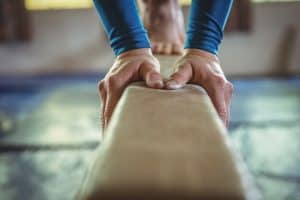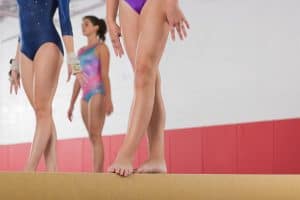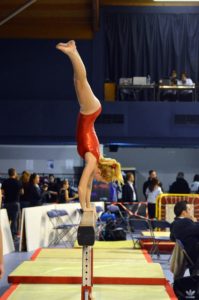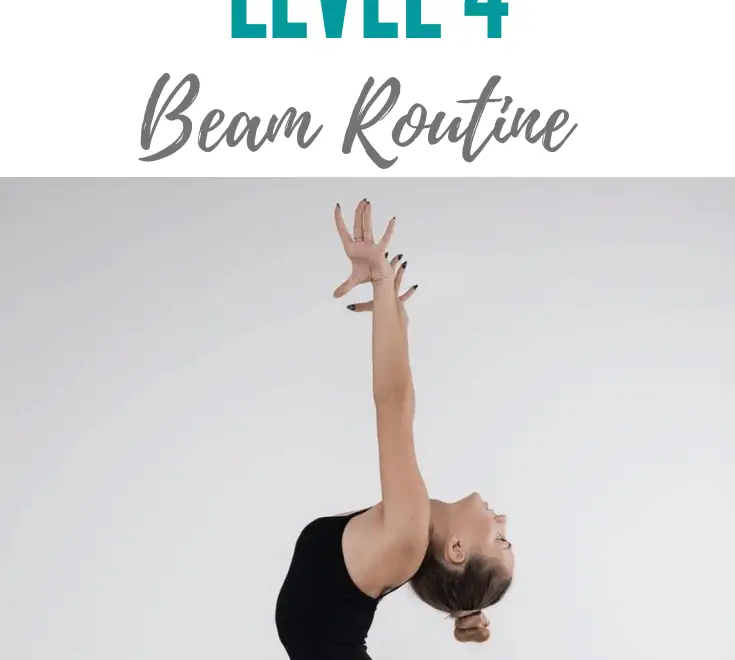Level 4 beam – love it or hate it? It starts to get harder in this level, with the addition of the cartwheel! But what’s the best way to get a big score? If you read the Level 3 beam article, many of the same principles apply here to Level 4 beam. Let’s take a look!

Introduction to Level 4 Beam
The same as in the other levels, the way to get the biggest score improvements is to get your major elements as clean as possible!
First, make sure you are using good form and technique. This includes straight legs and arms, pointed toes, and a straight-hollow body position where indicated. Obviously, wobbles and falls are big deductions, but body position errors can add up to be even more costly than those.
Next, make sure the major elements are performed as written in the text. Be sure to hold the elements that require a hold, perform leg and arm positions as written, and ensure that specific element deductions are at a minimum. More on those later.
Finally, check for general deductions. Are the connections and choreography performed to the text? Does the gymnast perform with good rhythm, artistry, and dynamics? Is she working high on toe? Does she appear sure of herself?
Now, let’s take a closer look at each of the types of errors in the Level 4 beam routine, and how to fix them!

Does your gymnast need a practice beam for home? Check out the recommendations in The Best Gymnastics Beams for Home!
Level 4 Beam Skills
The Level 4 beam routine consists of the following skills:
- Front support fish pose mount
- Cartwheel
- ½ turn
- Stretch jump, split jump 120°
- Handstand
- Scale (horizontal)
- Straight leg leap 120°
- Cartwheel to side handstand, ¼ turn dismount
General Deductions for the Level 4 Beam Routine
General execution deductions are ones that can be taken on any major element (skill) in a compulsory routine. Here is a list of general execution deductions that could be taken during a beam routine:
- Foot form – 0.05
- Leg separation – Up to 0.20
- Body alignment/position/posture in major elements – Up to 0.20
- Bent arms or legs (max deduction at 90 bend) – Up to 0.30
- Balance errors – Up to 0.30 (each)
- Grasping beam to avoid a fall – 0.30
- Fall (on or off the apparatus) – 0.50
- Failure to mark the passe position in releve at turn completion – 0.05
- Failure to contract or extend when indicated – Up to 0.10
- Leg swing/kick not to horizontal or above when required – Up to 0.10
- Incorrect leg alignment in arabesque – Up to 0.10
- Failure to perform turns in high releve – Up to 0.10
- Uneven leg separation in leaps/jumps – Up to 0.20
- Failure to keep arms by ears during entrance/exit of slow acro elements – 0.05
- Failure to land with feet together on 2-foot landing of jumps – Up to 0.10
- Insufficient split – Up to 0.20
- Incomplete turns – Up to the value of the element (usually 0.40)
Technique Changes for the 2021-2029 Compulsory Cycle
- No kicks into acro elements
- No straight leg entry into acro elements
- Two choices for acro entries: lunge entrance or mountain climber entrance
- Two choices for acro exits: lunge exit or step-in exit to straight stand
If you’ve coached prior to 2021, you’ll notice that these are different from past compulsory routines, but there are more options now to allow for flexibility in coaching techniques. Win-win for everyone!
Level 4 Beam Routine
In addition to the general deductions just discussed, each skill has specific deductions that can be applied just to that skill. Here’s a breakdown of the specific element deductions.
Front Support Fish Pose Mount
The Level 4 beam routine begins with a front support fish pose mount.
A fish pose is a pose in which one leg is straight and the other is bent, with the knees together. The gymnast must show an extended body in the front support position, or an up to 0.10 deduction can be applied.
An up to 0.10 deduction can be taken if the transition from the mount to stand is not continuous. If the gymnast performs a knee scale as she transitions to standing, it is a flat 0.30 deduction. A knee scale is a pose in which the gymnast is on one knee and the back leg is lifted off the beam. Make sure to drop the leg straight down to the side of the beam to avoid this deduction!
Next, the gymnast will perform a standing pose and a passe pose before the cartwheel.
Cartwheel
There are two acceptable entries into the cartwheel: a lunge entrance or a mountain climber entrance. The hands should be placed on the beam one at a time (0.10 deduction for simultaneous hand placement). If the gymnast does not go through vertical (the cartwheel goes around the side), she will receive an up to 0.30 deduction. It is NOT required to lever in or out of the cartwheel, but the arms must stay by the ears on the entrance and exit of the cartwheel (0.05 each).
Other deductions that can be applied to the cartwheel are bent arms (up to 0.30), bent legs (up to 0.30), foot form (0.05), and body position (up to 0.20). The body should remain straight and stretched throughout the cartwheel.
The gymnast can finish the cartwheel in a lunge, or use a step-in finish, in which the legs are straight and the feet are closed.

Side lunge, poses, lock
This series is not a major element, so there are no specific element deductions. Instead, general deductions will apply. I might write a “P” on my paper for poor posture, “F” for steps that are not in releve or onto sickled feet, or “T” for text errors.
1/2 turn
The free leg should be in forward passe during the 1/2 turn (0.10 deduction). This turn should be performed using one of the acceptable techniques from the Compulsory Handbook (0.30 deduction for heel-snap turn).
As always, good posture is a must during the turn (up to 0.20), and it should be performed in high releve (up to 0.10). The gymnast should “mark”, or show, the passe position at the end of the turn, or a 0.05 deduction will apply.
If the turn is incomplete, the gymnast will be deducted up to the value of the element (up to 0.40).
After the turn, the gymnast steps into a lock stand. Look for good foot form and body position during the lock stand.
Backward kick, poses
This is another choreography series without any specific deductions, but the gymnast should take care to maintain good posture with pointed feet. The gymnast may lean forward during the backward kick, as long as she shows an arch in her upper back.
Stretch jump, Split jump 120°
Another name for a stretch jump is a straight jump.
The emphasis during the jumps is on posture and amplitude. The jumps should show good height (up to 0.20 each), with the gymnast pushing through the feet and pointing her toes (0.05). She should land with good posture (up to 0.20 each). Deductions also apply for bent knees and balance, if these errors occur.
The split jump requires a split angle of 120°, or an up to 0.20 deduction can be applied. If the gymnast’s split is uneven, with one leg higher than the other, the deduction is up to 0.20.
Other specific deductions include failure to land with feet closed on the split jump (up to 0.10), failure to land on both feet at the same time (0.10 each jump), and poor connection between the jumps (0.05).
If the gymnast loses her balance or falls between the jumps, the deduction for lack of connection is only 0.05, regardless of what type of broken connection occurs. There is no deduction for a slow connection between the jumps.
Handstand
In Level 4 beam, the handstand should be in vertical and held one second. There is a deduction of up to 0.30 for lack of vertical. If the gymnast does not achieve vertical, or if she achieves it but steps right back down, she will receive the deduction of up to 0.10 for not holding the handstand. There is also a deduction of 0.10 if the legs do not close together, side by side. The hands should be placed side by side, or a deduction of 0.10 for incorrect hand placement can occur.
In addition, general body position deductions apply to the handstand. The gymnast can lose tenths for arched or piked body, poor head and shoulder position, bent knees or arms, and poor foot form. There are a lot of possible deductions for the handstand, so this is a very important skill to practice!
After the handstand, the gymnast performs a lock stand and a squat turn, which are not major elements. Focus on body posture, foot form, and correct arm positions to avoid general deductions at the end of the routine.
Scale (horizontal)
The chest is allowed to tilt forward slightly during the scale, but the forward lean should not be excessive. A deduction for posture can be applied if the gymnast lowers her chest too far.
When the gymnast leans forward to begin the scale, the free leg must lift to at least horizontal (up to 0.20). The scale must be held one second, or the gymnast could receive a deduction of up to 0.10.
Deductions can also be taken for bent legs (up to 0.30) and foot form (0.05).
Straight Leg Leap (120°)
The leap should be performed with straight legs. If the front leg bends (gymnast performs a stag leap), a deduction of up to 0.10 is applied.
The split requirement is 120°, and the front and back legs should be even during the split. Deductions apply for insufficient split (up to 0.20) and uneven split (up to 0.20).
The emphasis during the leap is on posture (up to 0.20) and height (up to 0.20). The gymnast should land in an arabesque position and pause there (0.05) before performing her lock stand.
General deductions also apply for leg and foot form (up to 0.30 and 0.05, respectively).
Cartwheel to side handstand, 1/4 turn dismount
The Level 4 beam dismount is the same as the Level 3 dismount. Most of the specific deductions relate to an incomplete dismount. We’ll get to that in a minute.
Other specific deductions are as follows. The hand should stay on the beam until the body passes the beam (up to 0.10). If the hands are placed simultaneously, a 0.10 deduction applies.
In addition, body position deductions apply to this dismount. Most commonly, a gymnast will show an arched or piked body (up to 0.20), bent arms (up to 0.30), leg separation (up to 0.20), and poor foot form (0.05).
Incomplete dismount Example
Now, let’s look at an example of an incomplete dismount. In this example, the gymnast does not achieve a vertical position in her handstand, falls, and does not get back up.
She will receive a deduction of up to 0.30 for the lack of vertical and 0.50 for the fall. Since she does not perform the 1/4 turn, she gets a flat 0.20 deduction. If she did not hold the handstand, she receives an up to 0.10 deduction. This is a total of 1.1 in deductions for a fall on the dismount!
If the gymnast tries the dismount again and makes it, she no longer receives the deductions for lack of vertical, lack of hold, and incomplete ¼ turn.
The big question is, should she try it again? It depends.
If she usually makes her dismount and you are confident she will make it on the second try, have her try it again. If it’s questionable whether she’ll make the second try, you may not want to risk another fall. In that case, it could make sense to have the gymnast end her routine after the first attempt.
Another consideration is the gymnast’s ability to perform the dismount with good body position. If she has body position errors on her dismount, she’ll be deducted for those errors each time she attempts the dismount. In some cases, a gymnast may earn back a few tenths by making the second dismount, but if she loses an equivalent amount in body position errors, she’s no better off.

General Routine Deductions for a Level 4 Beam Routine
During the choreography components of the Level 4 beam routine, also called non-value parts (or non-VP’s), general deductions are used. Judges make notes of small errors during the routine in each of the general categories, and determine a total deduction after looking at the routine as a whole.
General deductions on beam consist of the following:
- Text errors – up to 0.30
In the compulsory handbook, this is described as “incorrect position of head, arms, legs, or feet”. - Artistry – up to 0.30
This deduction is broken down into two parts: up to 0.15 for quality of the gymnast’s movement to reflect the choreography, and up to 0.15 for quality of expression, including projection, emotion, and focus. - Rhythm – up to 0.20
Rhythm deductions are taken for not performing the routine in time with the music, or performing a section with incorrect rhythm compared to what is listed in the text.. An additional 0.10 can be taken if the gymnast does not end the routine in time with the music. - Posture: up to 0.30
This can be applied for any postural errors during choreography, such as ribs out, bottom out, head forward, shoulders slumped, etc. - Footwork – up to 0.30
Feet should be pointed anytime they leave the ground, and the gymnast should stand and step in releve when indicated. She should also show turn-out in her foot positions. - High releve: up to 0.20
Gymnast should perform steps and pivot turns in high releve throughout the routine, when indicated. - Dynamics: up to 0.20
The gymnast should perform her routine with full extension and good energy, and she should make the difficult look effortless. - Sureness: up to 0.20
The gymnast should appear sure of herself, and display confidence in her movements throughout the routine.
For more detail on general deductions, read this post on general deductions in compulsory routines.
Closing Thoughts
To sum it up, there are three components to maximizing your Level 4 beam score. The first component is clean execution of all major elements. Second, make sure the elements are free from specific element deductions. Last, minimize general deductions – show off that routine and make sure it flows well! The Level 4 beam routine can be so lovely when it’s performed well, and now you’re well on your way to doing a beautiful routine!
Further Reading
Check out these articles for more about compulsory beam, and other Level 4 events!
How to Perform the Best Level 2 Beam Routine
How to Perform the Best Level 3 Beam Routine
How to Perform the Best Level 5 Beam Routine
How to Perfect Your Level 4 Bar Routine
5 Tips for a Stellar Handspring Vault
General Categories for Exemplary Compulsories
The Best Gymnastics Beams for Home
References: USA Gymnastics J.O. Compulsory Handbook, 2013-2021.
